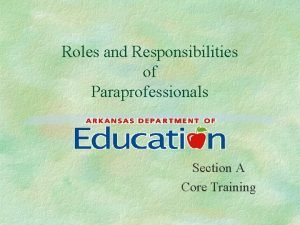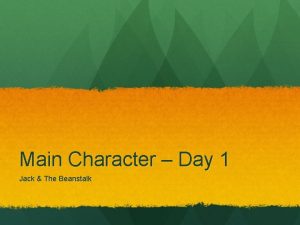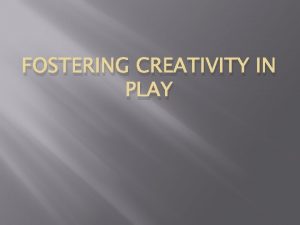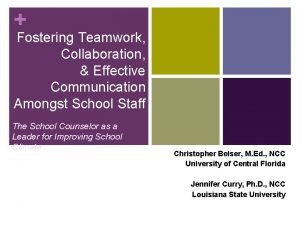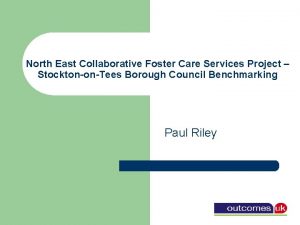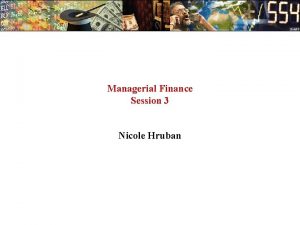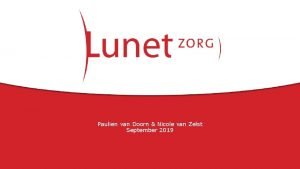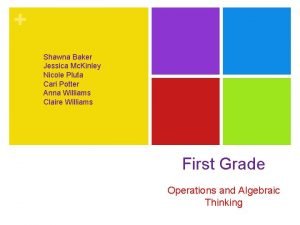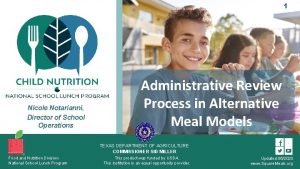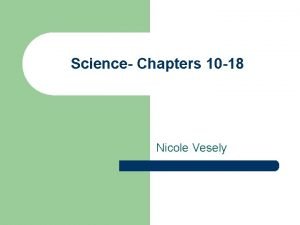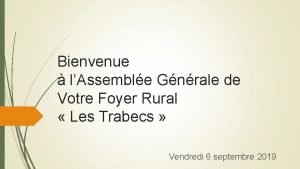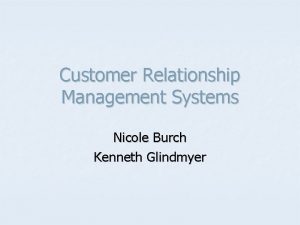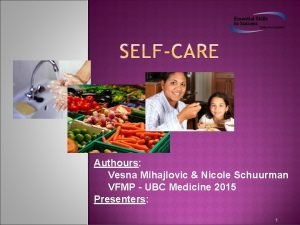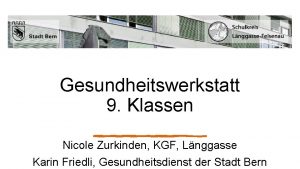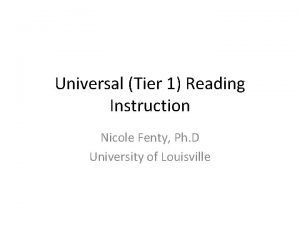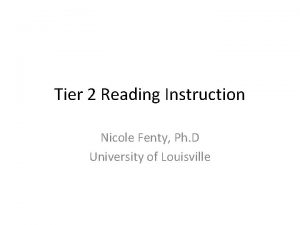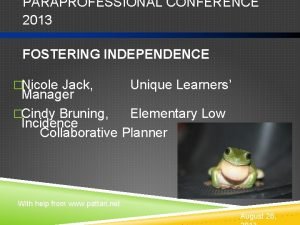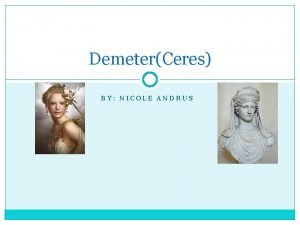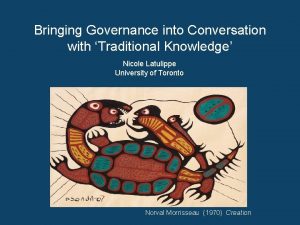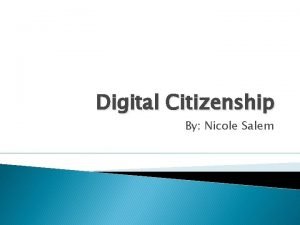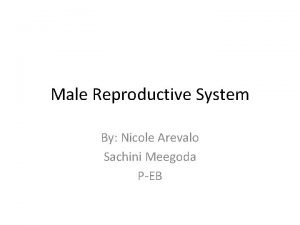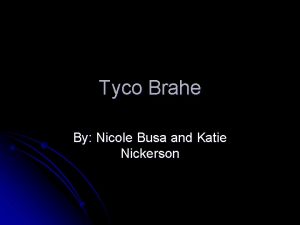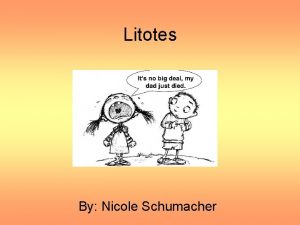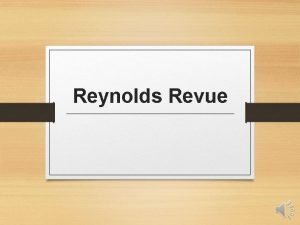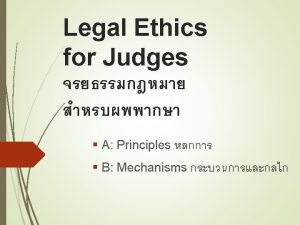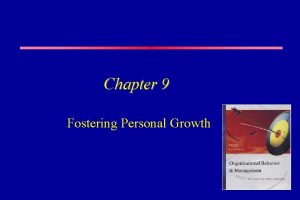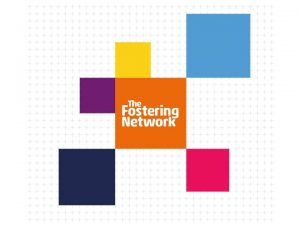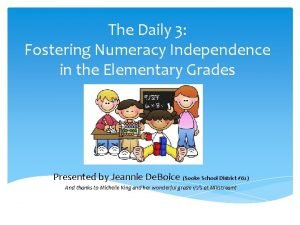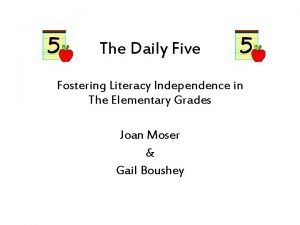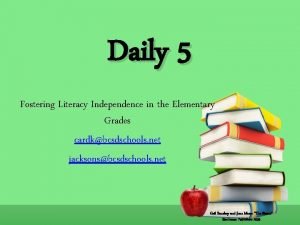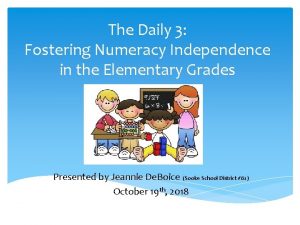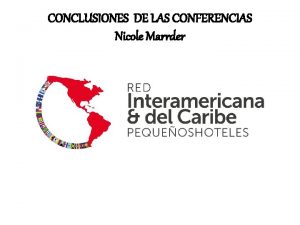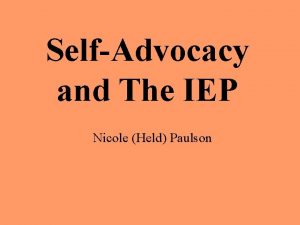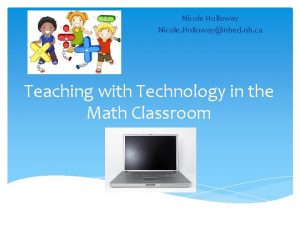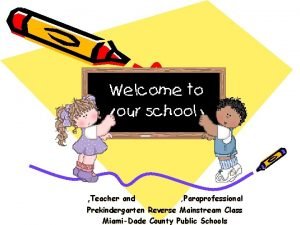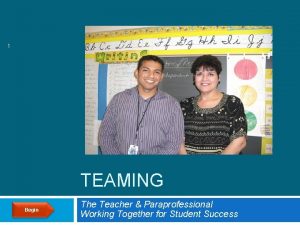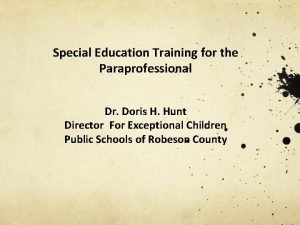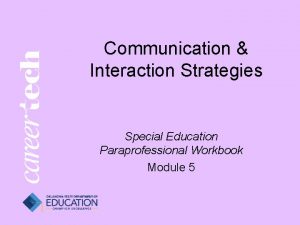PARAPROFESSIONAL CONFERENCE 2013 FOSTERING INDEPENDENCE Nicole Jack Unique






































































- Slides: 70

PARAPROFESSIONAL CONFERENCE 2013 FOSTERING INDEPENDENCE �Nicole Jack, Unique Learners’ Manager �Cindy Bruning, Elementary Low Incidence Collaborative Planner With help from www. pattan. net August 28,

OUR COMMITMENT TO LEAST RESTRICTIVE ENVIRONMENT (LRE) Our goal for each child is to ensure Individualized Education Program (IEP) teams first consider placing the student in the general education setting using Supplementary Aids and Services before considering a more restrictive environment

LEARNER OUTCOMES Participants will: �Identify effective strategies to move students from dependent to independent learning. �Examine the role of self-management in independent learning.

CONSIDER… “Ultimately, the goal of academic and social skill instruction is to enable students to function independent of external or teacher-mediated interventions and control”. (p. 508) Wolery, Bailey, and Sugai (1988)

COMPONENTS OF EFFECTIVE INSTRUCTION �Stages of Learning �Setting Students Up for Success �The Instructional Process �Feedback �Generalization


Activity #1

Stages of Learning Application Behavior extended and used in new ways Generalization Behavior transferred to other settings, persons, or materials Maintenance Fluency and accuracy of behavior retained Proficiency Behavior performed with high accuracy and fluency Acquisition Behavior performed with high accuracy (about 80%-90%) Entry Behavior performed at slow rate or not at all. Increasing degree of independence adapted from D. P. Rivera and D. D. Smith, 1997. Teaching Students with Learning and Behavior Problems, (3 rd ed. )

SETTING STUDENTS UP FOR SUCCESS Effective Instructional Practices �Students who experience high success rates in school have better learning outcomes than students who experience low success rates. �Students can reach a higher level of independence through instruction that is explicit.

Setting Students Up for Success By providing instruction that is: ü Direct and Explicit ü Errorless ü Matched to student’s achievement level You will: Minimize: Maximize: Errors Instructional time Frustration and Opportunities for inappropriate behaviors Future errors reinforcement Future success

1 2 3 4

1 3 2 4

SETTING STUDENTS UP FOR SUCCESS How? �Appropriate instructional tasks and task level �Analysis of skills and routines �Appropriate prompts, cues, and fading �Appropriate feedback �Plan for Generalization

THE INSTRUCTIONAL PROCESS �What comes before instruction �Environment �Time � Physical factors

THE INSTRUCTIONAL PROCESS �Instruction considerations �Task Analysis �Best Method of Presentation

THE INSTRUCTIONAL PROCESS �The skill or routine itself �Task Analysis �I do, we do, you do �Best method of presentation

THE INSTRUCTIONAL PROCESS �What comes after instruction? �Feedback �Generalization

FEEDBACK �Be Explicit �Be Enthusiastic �Language Level �Reinforcement �natural vs. contrived �Shape Responses

GENERALIZATION : 3 FORMS OF KNOWLEDGE �What �factual information about a topic �How �procedures for using the information in specific ways �steps to follow to complete a task �When �when and where to apply the information

GENERALIZATION �Teach the range of examples �‘How to’ vs. ‘when to’ �Authentic practice

GENERALIZATION �Identify the cues to trigger the use of the skill �Encourage others to coach the skill �Standardize routines across classrooms �Pair rewards with naturally occurring reinforcement �Expand student responses Extending Learning Across Time & Space : The Power of Generalization

GENERALIZATION EXAMPLE 1 Sara, a 4 th grade student, has a oneyear reading delay and needs lots of practice in reading to increase her rate of decoding. However, she never picks up a book outside of school.

GENERALIZATION EXAMPLE II Jack, an 8 th-grade student, gets into fights frequently and has poor relationships with peers. He participates in a social-skills group. When interacting with other students under the watchful eye of the school counselor, Jack shows that he is able to identify when he becomes angry and employ several strategies to calm himself down. In unstructured settings such as the lunchroom or hallway, though, Jack continues to get into arguments and shoving matches with other students.

GENERALIZATION EXAMPLE III Thomas has learned terrific study skills in his 7 th-grade social studies class. His class notes were once in shambles- but now are neatly written and thorough. In science class, however, Thomas’ notes continue to be messy and incomplete, and his science test grades suffer as a result.

WHAT, HOW, WHEN Topic_________ What (factual information) ________________________________________________ How (procedures or steps) ________________________________________________ When (when to use, multiple examples) ________________________________________________

WHAT (FACTUAL INFORMATION) COUNTING TO 20 How (procedures or steps) Fade verbal prompts Ask questions about how many bears will we find today in our cup? Expose student to counting the # items and people throughout the day. I do, We do, You do process of teaching When (when to use, multiple examples) Discuss other times to use counting throughout the students day and while out in the environment. Discuss big(>20) vs small groups of items and then count to determine big or small.

YOUR TURN – WHAT, HOW, WHEN �Requesting Help from Teacher or Peer �Writing a Friendly Letter �Reading sight words �Telling Time

Paraeducator’s Role My Student (s) Set Students up for Success Instructional Process – Before, During, After Feedback Generalization I do this by… I’ll try…

REFLECTION � Do you find your students only display correct responses (behaviorally/academically) for you, but not in the presence of other educational team members or parents? � Yes or No � Do you find yourself frequently needing to prompt your students to start, continue, or complete tasks? � Yes or No � Do your students have frequent opportunities to demonstrate responsibility for their own learning? � Yes or No � Do your students know how to evaluate their own behavior and learning ? � Yes or No

Strategies to Promote Independence • Can’t Do vs. Won’t Do • Methods of Prompting • Choice Making • Schedules

Stages of Learning Application Behavior extended and used in new ways Generalization Behavior transferred to other settings, persons, or materials Maintenance Fluency and accuracy of behavior retained Proficiency Behavior performed with high accuracy and fluency Acquisition Behavior performed with high accuracy (about 80%-90%) Entry Behavior performed at slow rate or not at all. Increasing degree of independence adapted from D. P. Rivera and D. D. Smith, 1997. Teaching Students with Learning and Behavior Problems, (3 rd ed. )

Strategies to Promote Independence A word about independence…

STRATEGIES TO PROMOTE INDEPENDENCE Can’t Do Vs. Won’t Do

IF A STUDENT CAN’T PERFORM A TASK… �Teach the task �Adapt the steps �Student, content, presentation �Change the motor demands of a task �Change the sequence of steps �Modify the materials or use different materials �Assist to complete the task �Work with a peer or in a small group �Adult assistance to complete a step

IF A STUDENT WON’T PERFORM A TASK �Rearrange the Set-Up to the Task �Change the Reinforcement Options �Use Behavioral Momentum � 3 or 4 easy tasks before a difficult task

STRATEGIES TO PROMOTE INDEPENDENCE Methods of Prompting �Provide enough prompts to prevent student from making a mistake and then fade prompts (errorless learning) �Wait until student attempts, then prompt if they make an error. Give the least amount of assistance needed.

CUES AND PROMPTS Cue - A signal to say or do something Prompt - Assistance to say or do something

CUES �Natural cues �Imposed cues �Questions �Options �Auditory �Visual �Tactile

TYPES OF PROMPTS Verbal Direct - a clear statement of what student should do Indirect - ask a question, such as “what should you do next? ” Physical Full - Hand under hand Partial - Supportive guidance Modeling - show student/student imitates Gestures - pointing, facial expression

EXAMPLES OF PROMPTS Direct Verbal Tell student- get your pencil Indirect Verbal Ask “What do we do next? ” Tell student- keep Ask “now what? ” working until timer rings Say “ remember, you need how many forks? ”

EXAMPLES OF PROMPTS Full Physical Assistance Partial Physical Assistance Hold pencil with Support student at Hold student’s Tap elbow of student to write name. hand to assist with holding a cup. wrist to stabilize handwriting. student to initiate spoon to mouth.

EXAMPLES OF PROMPTS Modeling Write student’s name and then he writes it Gesture Put your finger on your mouth to remind student to be quiet Show student how you take a drink, then he takes a drink Point at the correct item to pick up next

REDUCING PROMPT DEPENDENCY �Use systematic routines �Use natural cues �Use Wait Time �Plan to Fade Prompts

REDUCING PROMPT DEPENDENCY 2 �Use systematic routines �Use natural cues �Use Wait Time �Plan to Fade Prompts

GOALS OF TEACHING CHOICE-MAKING �Goal #1: Communicate their choice selection �Goal #2: Selections will result in a preferred outcome �Goal #3: More sophisticated choice- making skills and expand choice opportunities

STRATEGIES TO PROMOTE INDEPENDENCE Choice-making �Reduces behavior problems �Increases motivation �Promotes generalization �Prepares student for independence

STRATEGIES TO PROMOTE INDEPENDENCE 2 Choice-making �Reduces behavior problems �Increases motivation �Promotes generalization �Prepares student for independence

Please Remember… Many students with disabilities have fewer opportunities to make choices throughout the day. It may be assumed that they do not have the capacity to make a choice, that they will not make the ‘right choice’ or that they don’t really have a preference. We can help promote self-confidence and self-determination if we build in opportunities for students to make choices and decisions throughout the day. This can transfer a sense of self-control and responsibility for oneself to the student by having them make choices.

STRATEGIES TO PROMOTE INDEPENDENCE Choice-making opportunities: �Between Activities �Within Activities �Refusal �Who �Where �When �Terminate

STRATEGIES TO PROMOTE INDEPENDENCE Schedules: �To Do Lists �Calendars �Planners/agendas �Visual activity/task schedules

STRATEGIES TO PROMOTE INDEPENDENCE

STRATEGIES TO PROMOTE INDEPENDENCE

Paraeducator’s Role My Student (s) Prompts and Cues Making Choices Schedules I do this by… I’ll try…

SELF MANAGEMENT Any purposeful and systematic set of responses by an individual that change or maintain some aspect of the individual’s behavioral repertoire. ( Daly & Ranalli, 2003)

MONITOR YOUR PARTICIPATION + - • Listening to speaker • Participating in assigned activity • Using “inside” voice” • Texting • Unrelated sidebar conversation • Engaged in other activity = + = -

SELF MANAGEMENT Self Monitoring Self Reinforcement Self Instruction

SELF MONITORING On a personal note… � List behaviors in your own life you’ve planned to increase, change, or decrease. � How did you do it? How did you keep track? ______________________

STEPS TO TEACHING SELF MONITORING 1. Select and define a target behavior or 2. 3. 4. 5. class of behaviors Select or develop a recording method Teach the student to monitor/record the target behavior Evaluate progress Fade self monitoring

SELF MONITORING �Student decides if the behavior occurred or did not occur �Student objectively records the frequency of a given behavior or a class of behaviors �Student and teacher rate the behavior �Teacher and student may initially rate the behavior simultaneously �Teacher and student discuss agreement or disagreement in their ratings

SELF REINFORCEMENT Administering a reinforcement to yourself after you have reached your goal! Bloomquist, 1996

SELF REINFORCEMENT �Requires �Self imposed criteria of performance established before monitoring �Self determination that the performance criterion has been met prior to reinforcement �Free access to reinforcers Shapiro & Cole

TYPES OF REINFORCERS �Material - food, drink, toys �Social – praise, facial expression, nearness, contact �Activity – T. V. time, free time, listening to music �Tokens – tickets, points, etc. that can be “cashed in” for other types of reinforcers �Covert – thoughts and self evaluation Remember: It’s not reinforcing unless the behavior is maintained or increases!

SELF REINFORCEMENT On a personal note… �Based on your previous conversation, did you set a criteria? _________________________ �Did you reward yourself? ___________________________

SELF INSTRUCTION �Student is taught to make specific self statements which prompt specific behaviors Examples: �Look before you leap �Take a deep breath �Count to 10

SELF INSTRUCTION �Define a task to be learned �Verbalize a way to complete it �Evaluate own performance �Praise self when done accurately Wolery, Bailey, & Sugai

SELF INSTRUCTION On a personal note… What did you do to self instruct?

Paraeducator’s Role My Student (s) Self Monitoring Self Reinforcement Self Instruction I do this by… I’ll try…

LEARNER OUTCOMES Participants will: �Identify effective strategies to move students from dependent to independent learning �Examine the role of self-regulation in independent learning

19 Ways to Step Back Adapted from Classroom Collaboration, by L. J. Hudson, Ph. D. (Perkins School for the Blind) Challenge yourself and help your student: Try one new way to step back each day or week and practice the new strategy until it becomes habit to continue to reduce the support you give your students!

CONTACT INFORMATION �Nicole Jack, Unique Learners’ Manager njack@scred. k 12. mn. us �Cindy Bruning, Elementary Low Incidence Collaborative Planner cbruning@scred. k 12. mn. us Foster that independence! Don’t hold them back!
 Paraprofessional duties checklist
Paraprofessional duties checklist Describe jack from jack and the beanstalk
Describe jack from jack and the beanstalk Creativity and play fostering creativity
Creativity and play fostering creativity Fostering teamwork and collaboration
Fostering teamwork and collaboration Fostering hope scholarship
Fostering hope scholarship Fostering in doncaster
Fostering in doncaster Fostering stockton on tees
Fostering stockton on tees Fostering healthy solutions
Fostering healthy solutions Agile 2013 conference
Agile 2013 conference Nicole hruban
Nicole hruban Nicole antczak
Nicole antczak Nicole charest
Nicole charest Flg asperg lehrer
Flg asperg lehrer Sheri tague purdue
Sheri tague purdue Nicole sinclair md
Nicole sinclair md Le pome
Le pome Nicole yeats
Nicole yeats Nicole van doorn
Nicole van doorn Authoritarismus
Authoritarismus Nicole bogdanovich
Nicole bogdanovich Jessica pluta
Jessica pluta Nicole notarianni
Nicole notarianni Natalia castillejo duolingo
Natalia castillejo duolingo Rosa gallina
Rosa gallina Nicole schimmel
Nicole schimmel Nicole sirbu
Nicole sirbu Nicole
Nicole Nicole pinkham
Nicole pinkham Nicole vesely
Nicole vesely Nicole noel purdue
Nicole noel purdue Nicole friel
Nicole friel Nicole ong
Nicole ong Nicole brust
Nicole brust Nicole engdahl
Nicole engdahl Nicole burch
Nicole burch Nicole kleinstreuer
Nicole kleinstreuer Nicole schuurman
Nicole schuurman Nicole val
Nicole val Nicole alexander md
Nicole alexander md Nicole zurkinden
Nicole zurkinden Nicole hohenstein
Nicole hohenstein Nicole fenty
Nicole fenty Nicole nieto osu
Nicole nieto osu Nicole fenty
Nicole fenty Nicole
Nicole Nicole charest
Nicole charest The rime of the ancient mariner part 3
The rime of the ancient mariner part 3 Alana green
Alana green Demetersgarden
Demetersgarden Nicole charest
Nicole charest Jessica nicole jones
Jessica nicole jones Nicole latulippe
Nicole latulippe Nicole rivi
Nicole rivi Nicole salem
Nicole salem Nicole arevalo
Nicole arevalo Nicole lindbergh
Nicole lindbergh Jedec standard
Jedec standard Oj simpson bloody socks
Oj simpson bloody socks Nicole poleski
Nicole poleski Nicole van bergen
Nicole van bergen Nicole shriver
Nicole shriver Nicole richelle
Nicole richelle Nicole
Nicole Katie nickerson
Katie nickerson Nicole campese
Nicole campese Nicole guerriero agent
Nicole guerriero agent Litote
Litote Nicole ibrahim fda
Nicole ibrahim fda Nicole lizée
Nicole lizée Nicole hare-everline
Nicole hare-everline Nicole beale
Nicole beale
